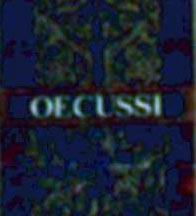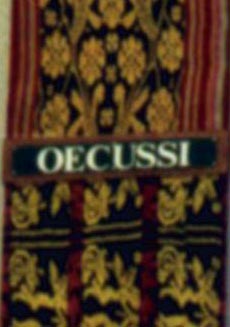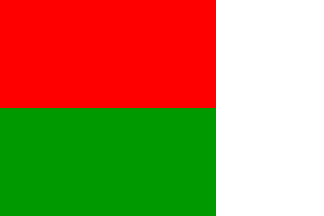
Last modified: 2006-01-21 by antonio martins
Keywords: ocussi ambeno | coat of arms | oé-cussi | micronation | quatair / ocussi ambeno | madagascar | imaginary | hoax |
Links: FOTW homepage |
search |
disclaimer and copyright |
write us |
mirrors
Oecusi-Ambeno is part of East Timor and will be a part
of independent Timor Lorosae. There’s no question about that.
Jorge Candeias, 25 Feb 2000
Ocussi Ambeno seems to be a de-facto Indonesian territory,
unrecognized internationally but so far uncontested legally by
Portugal. It was a Portugese enclave in the old
NEI with a border undefined until
1914, and the source of several military clashes between the
two colonial powers. Portugal neglected to re-occupy the
territory after WW2 — perhaps unwilling to take the risk of being
caught in the conflicts between Holland and the Indonesian
nationalists — and the territory drifted into diplomatic
oblivion.
Stephen Collier, 07 Oct 1999
This is false. Soon after WWII Indonesia got independent
and East Timor was subject to an agreement between Indonesia
and Portugal, by which Indonesia recognized the sovereignty
of Portugal over the territory and guaranteed that it didn’t
have any territorial ambitions over any part of the territory.
The territory was defined as the
portuguese possessions of
before the war: the eastern part of the island of Timor, the
island of Atauro to the north, the small island of Jaco off
the eastern tip of Timor and the enclave of Ocussi Ambeno in
the eastern half of Timor. Even after the invasion, Indonesia
maintained these territories together and separated from the
rest of the country as the province of Timor
Timur. The legal status of the territory is, therefore,
perfectly clear: it’s a part of East Timor, and has been so
since before WWII.
Jorge Candeias, 08 Oct 1999
The enclave is part of East Timor and will join the newly independent
country. The territorial make up of East Timor was never a debate issue,
rather only it’s status (either indonesian province or occupied portuguese
territory under a decolonization and independence process). Indonesian
occupation officials (unlike others in similar ciconstances) did not change
the borderlines fixed in 1912 between Portugal and the Netherlands, and
UN-sponsored independence referendum was held in the territory.
I find very hard to believe that «Portugal neglected
to re-occupy the territory after WW2». Granted that the
1926-1974 portuguese dictatorship contrasted it’s propaganda
imperial tone at home with a rather meek foreign policy
regarding it’s colonies (at least until 1961), allowing
almost without complaint the occupation of São Jorge da Mina
(Benin) and Portuguese
India — by these things were widely publicized and exposed
after the 1974 revolution. However nothing of the sort was
disclosed about Oecussi Ambeno…
Antonio Martins, 08 Oct 1999
I also find very hard to believe that «Portugal neglected
to re-occupy the territory after WW2». First of all because
the Grote Oost (Greater East, the islands east of
Java and Madura, so including [West] Timor) was the first
territory of the Netherlands Indies where the Dutch regained
control (well, in fact the Australians had done that for them)
after the war was finished. Second, because I don’t think the
Dutch would have allowed the “republicans” (supporters of a
unitary Republik Indonesia) to have control over the
exclave, nor they would have risked a conflict with the
Portugese by occupying it theirselves. And last, because West
Timor was one of the three ereas most anti-republican and
loyal to the Dutch (the other being Minahassa, in the upper
north of Celebes/Sulawesi, and the South Moluccas). As far as
I know, most of the fighting took place on Java, Sumatra and
the south of Celebes.
Mark Sensen, 11 Oct 1999
On the right and the left wall of the East Timor national parliament
are hanging traditional weavings, each with the name of one of the
districts. Each district has such a weaving
on the left and the right, but
there are not exactly the same, just similar.
J. Patrick Fischer, 08 Aug 2002


It may have existed, or not. Some, not all, portuguese overseas
municipalities recieved arms and flag in the period 1940-1974, after all
metropolitan municipalities got one.
Díli is the only one in Timor I know about.
António Martins, 15 Jan 2003
Originally at on line,
this seems to be a Portuguese
colonial or Army flag.
Several months ago I contacted the association that runs the site
(Associação dos Militares do Oé-Cussi, Former Portuguese Military
Serving in Oecussi Association), to get information about this flag, but
I got no answer. It seems that this photo was taken in 1999. It is written
that the former chieftain of Oecussi, D. José Hermenegildo da Costa, kept
the flag with the will to hoist it the day the Indonesians would leave
Timor-Leste. However, D. José was deported to Kupang, Indonesia and passed
away on November 4, 1999.
Francisco Santos, 26 May 2003
There is someone in New Zealand who issues stamps
for Ocussi Ambeno — but this is not the Timorese one,
but is rather a micronation, in much the same way as
one other micronation is called
Reunion.
James Dignan, 09 Dec 1997

On [mchXX], under the title
"Soukrome staty" there are 11 images of imaginary states,
incuding Ocussi Ambeno: red over green with at the fly [!] a
white vertical stripe (so, like the flag of
Madagascar mirrored). No source is given.
Mark Sensen, 11 Oct 1999
Soukrome staty means "private countries" or
"privately owned countries"…
Joàn-Francés Blanc, 12 Oct 1999
The “self proclaimed” sultanate was proclaimed by Bruce Henderson after 1968. The Sultan in 1968 was Wallis Abdullah I, and later Michael Abdullah. The postal adresses are:
Sultanate of Quatair / Ocussi Ambeno,I don’t know the flag but the coat of arms is with two oval wreaths, a crown above and 18 circles within the oval (in line 3, over 4, over 5 over 6, each time greater, over the word QUATAIR, over 8 five pointed stars over a great five pointed star. In the bottom a ribbon with the inscription "onward".
PO box 876, Auckland, New Zeland; or
Markpress box 21240, Auckland, New Zeland; or
Box 1619, Brisbane 4001, Australia
It sounds dreadfully
overdesigned. And inscription would likely be in Portugese, Bhasa
or Arabic. There’s no English connection beyond this
Auckland clique that I’ve ever heard of, so that’s probably how it got to say
"onward".
Stephen Collier, 07 Oct 1999
www.okusi.org/oa is the page of Okusi
Ambeno Sultanate <oastamps@post.com>
is the page of postal emisions I received a beatiful file about next post emission.
In the upper part is the emblem of the Ministry of post, with the arms of…
Brunei!!!
Jaume Ollé, 03 Apr 2000
That’s not surprising, since everything in that “sultanate” is a hoax. It’s
just an internet-based micronation with a spurious claim to territory in
real world.
Jorge Candeias, 03 Apr 2000
Yep, and the “national” coat of arms of this so called sultanate is the
arms of Indonesia with the central shiled blurred off.
Hardely imaginative, but… No flags, anyway. I still dont understand if this
is just a joke of some kind (the website has a lot of “give aways”, like that
bit about hallucinogenic mushrooms being a major export, or that garudas really
exist), or if they are still conning keen and not-so-clever philatellists.
António Martins, 04 Apr 2000
The so-called “sultanate” is a fiction, one of the
many micronations that have been created in the last
decades. Unlike some of these micronations (who have
real territory where real people live and claim
independence), this had only “territory” on the
Internet and on stamps catalogues. Also, the people
there are overwhelmingly christian (which is also a
political statement of resistence against the
indonesian opressor, predominantly muslim), so it
couldn’t be a sultanate. This helps to show the deep
ignorance of the guy who invented the sultanate story
about the sociological reality of the enclave, which
is also quite common in micronations that claim chunks
of “real-world” territory.
Jorge Candeias, 08 Oct 1999
This Bruce Henderson must be an alias of, a friend of, or even the real identity of, someone I once had the misfortune to share lodgings with in Perth. Although a liar and pain-in-the-arse, this man produced enough documentary evidence to eventually convince me of the following:
Sometime in the mid 1970s, he printed letterheads for the non-existent Consul General of Ocussi Ambeno, from Auckland (address i forget, but i saw these). He explained that he had discovered that Ocussi Ambeno “didn’t actually exist”, but was listed in atlases nevertheless. Around the same time, he and others printed extremely basic postage stamps to back up the nation’s reputation. These were done with rubber stamps individually, and featured cats, fish, teddy bears and steam trains. I was told that these were never intended to be taken seriously, but they were submitted without laughter to an international philatelic journal with covering letterhead from the “consulate” and appeared in the next issue as a curiousity — in the so-called cinderella section. I saw this issue.
This is as much as I can vouch for, and it’s a shame I can’t verify what happened next…though i did see many sample sets of the “real” stamps. Here’s the story:
Two months later, a major European-based engraver/publisher writes to the consulate in Auckland and expresses cordial greetings, sympathy for the position of struggling small nations etc. Oblique correspondence gives way to enquiries about the diplomatic hierachy; is the sultanate’s man in Auckland the senior man overseas? does the consulate in Auckland have any particular needs that could be addressed? It’s noted that he is a keen philatelist. It’s pointed out that the publishing company prints stamps, very good ones, and specializes in international “covers”, large packages and long term client relationships. Company would be prepared to pay “fee” for exclusive contract, and right to market comemmorative sets to investors…
And the story goes that $US 30 000 changed hands. Everything was done properly and quickly; the stamps arriving in time for the Queen’s silver jubilee - that was the theme they celebrated. The printer placed tropical fish and animals on them, for reasons of continuity no doubt.
The money went on parties, and when they’d sobered up and realised that the printer wouldn’t prosecute them but might well take action privately, the rest of it went on changing identities and moving to Australia.
Stephen Collier, 07 Oct 1999
Other sites: